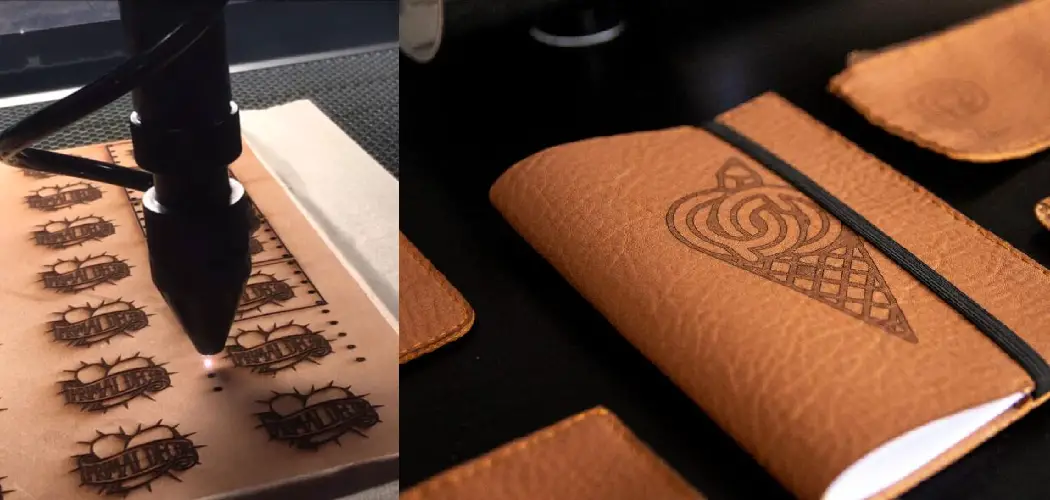If you’re looking to add a custom touch to a piece of leather, laser engraving is the way to go! It’s a great way to personalize your belongings, and the results are stunning. In this tutorial, we’ll show you how to laser engrave leather. Keep reading for all the details.
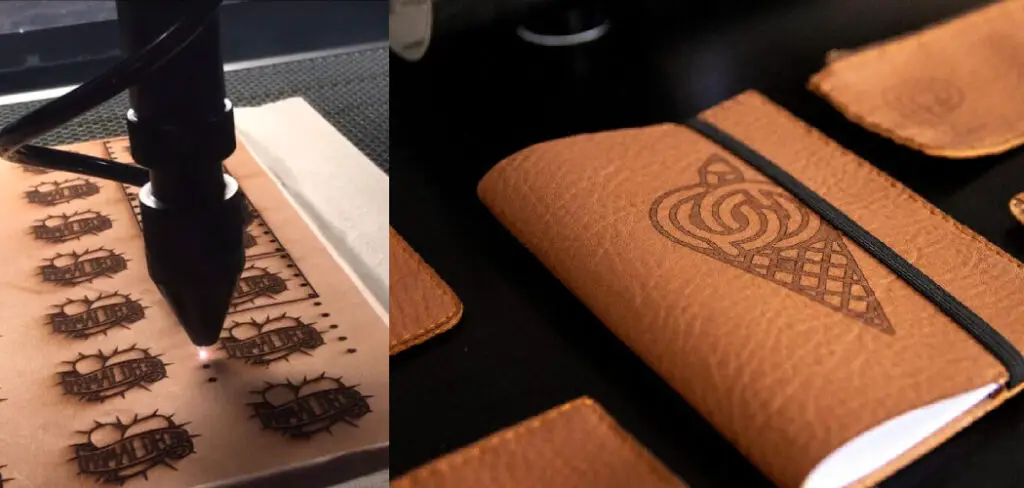
Summary: Leather engraving is a popular and simple way to add personalization and detail to leather items. The laser engraving process involves using a laser cutter to create a design by burning or melting away the surface of the leather, allowing you to create intricate patterns and detailed images on your items. The end result can be permanent or temporary, depending on the type of laser used and the settings used during the engraving process.
What Is Laser Engrave Leather?
Laser engrave leather is a process of using a laser to remove the top layer of fibers from the hide of an animal. This is done by directing intense light beams at the skin’s surface. The heat from the laser breaks down the collagen in the skin, causing it to lose its color and become etched with the design.
Laser engraving leather is a permanent process that can be used to create intricate designs and patterns on leather goods. It is often used to personalize items such as wallets, belts, and watches. The process is also gaining popularity in adding unique embellishments to clothing and accessories.
Unlike traditional methods of engraving, laser engraving does not require using harsh chemicals or dyes. This makes it a safer alternative for people with sensitive skin. Laser engraving leather is also more precise than hand-engraved techniques, making it possible to create highly detailed designs.
Why Should You Laser Engrave Leather?
There are many reasons to laser engrave leather. Leather is a durable material that can last for years, making it an ideal choice for items that will be used frequently or passed down through generations. In addition, laser engraving provides a permanent, high-quality finish that won’t rub off or fade over time.
It’s also an exact process so that you can create complex designs and patterns with ease. In addition, laser engraving is relatively quick and easy to do, so that you can finish your project in no time. So if you’re looking for a way to add a unique and personal touch to your leather goods, laser engraving is the way to go.
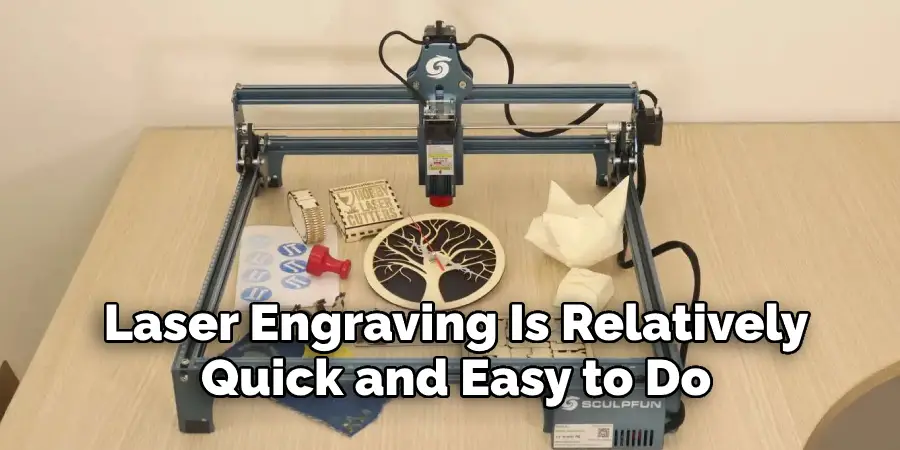
How to Laser Engrave Leather Step by Step Guide
Leather is a great material to laser engrave because it is durable and can take on a lot of detail. However, there are a few things you need to know before you get started.
1. Choose the Right Leather
The two most common types of leather are aniline and semi-aniline. Aniline leather is made from pure animal hide that has been dyed to add color. Semi-aniline leather undergoes a similar process, but with the addition of a protective topcoat. This makes it more durable and less susceptible to staining.
2. Prepare the Leather
Before you start engraving, you need to prepare the leather. This involves cleaning it and ensuring there is no surface dirt or debris. You also need to condition the leather to make it more pliable and prevent it from cracking.
To clean the leather, use a damp cloth to wipe down the surface. Be sure to remove all dirt, grease, and debris.
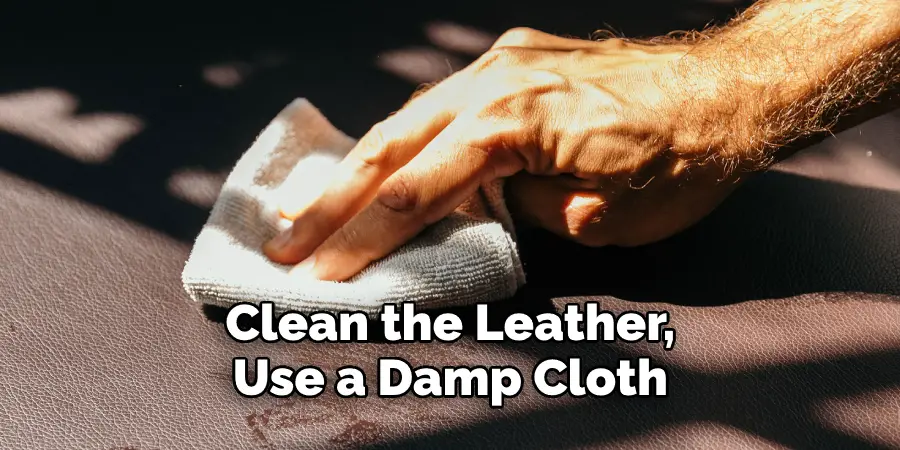
After washing, use a leather conditioner or oil. Apply it to the surface of the leather and rub it in with a soft cloth. This will help to prevent cracking and make the leather more pliable.
3. Create Your Design
Once you have prepared the leather, it’s time to create your design. If you’re not artistic, don’t worry – there are plenty of resources available online that you can use. Once your design is ready, it’s time to transfer it onto the leather.
There are a few different ways to do this, but the most common is to use carbon paper. Simply place the carbon paper underneath the leather, and then trace your design onto the paper. The carbon will transfer onto the leather, creating a perfect outline for you to follow.
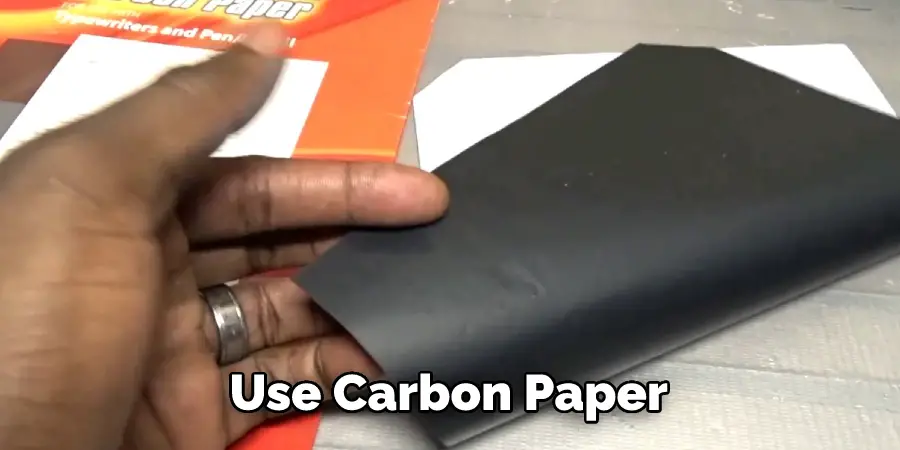
4. Start Engraving
Now it’s time to start engraving. If you’re using a laser engraver, the process is relatively simple. Just place the leather on the bed of the machine and let it do its work.
The process is a bit more difficult if you’re using a hand-held engraver. You’ll need to slowly and carefully move the engraver across the leather’s surface, careful not to apply too much pressure.
You Can Check It Out To Make Leather Goods
5. Finishing Up
Once you’re finished engraving, you’ll need to do some cleaning. Start by removing any loose pieces of leather or debris from the surface. Then, use a soft cloth to wipe down the area. You may also want to use a leather conditioner to protect the engraving and keep the leather looking its best.
Now that you know how to laser engrave leather, you can create some amazing designs. Just remember to take your time and be careful not to apply too much pressure. With a little practice, you’ll be an expert in no time!
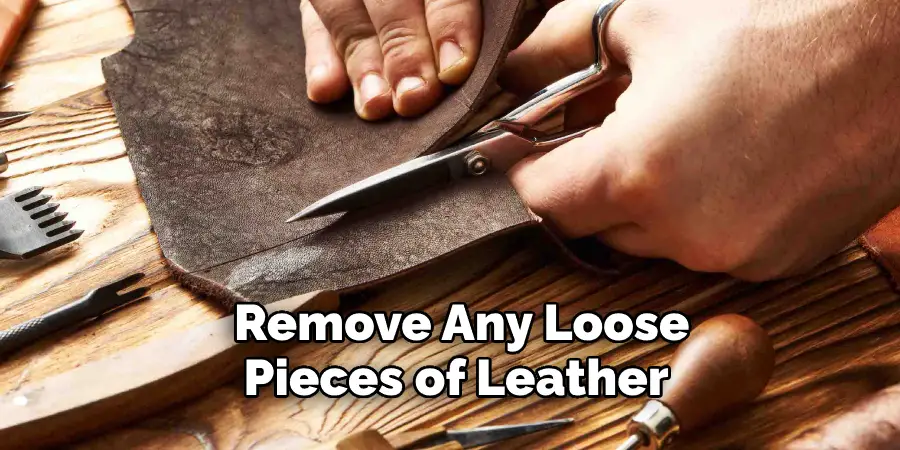
What You Need to Know Before Laser Engraving Leather
Leather is a timeless material that can be used for various applications, from clothing to furniture. And thanks to modern technology, it’s now possible to add a personal touch to leather goods with laser engraving. However, if you’re considering laser engraving leather, there are a few things you need to know first.
The type of leather you choose will greatly impact the engraving process. For example, hard leather like chrome-tanned cowhide produces clean, sharp lines, while softer leathers like vegetable-tanned hide yield more muted results. The thickness of the leather will also affect the final product, so it’s important to select a piece that is neither too thin nor too thick.
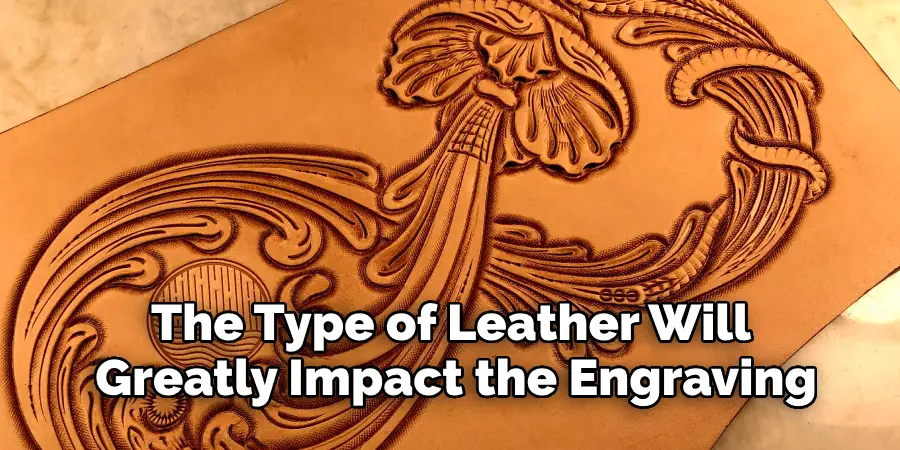
When it comes to engraving leather, there are two main approaches: direct engraving and indirect engraving. Direct engraving involves using a laser to cut through the top layer of the leather, revealing the lighter-colored layer beneath.
Indirect engraving, on the other hand, uses heat to darken the surface of the leather without cutting through to the layers underneath. Both methods can produce stunning results, so it’s a matter of personal preference.
No matter your chosen method, the key to successful laser engraving is to use a low-power setting and make multiple passes over the same area. This will help prevent the leather from burning or scorching. It’s also important to keep the laser moving to avoid concentrated heat build-up.
How to Choose the Right Leather for Your Project
There are many different types of leather available on the market, and each has its unique properties. As a result, it’s important to choose the right leather for your project to get the best results. Here are a few things to keep in mind when making your selection:
- The first step is to identify the type of project you’ll be working on. For example, are you looking for something durable, like a new sofa? Or are you working on a smaller scale project, like a purse or wallet? This will help you narrow down your options.
- Once you know what you’ll be using the leather for, look at the different grains and finishes available. Leather comes in various textures and colors, so you’ll want to select something that matches your vision for the project.
- Consider how the leather will be used. If it sees a lot of wear and tear, you’ll want to choose a more durable option. On the other hand, if it’s for something that will be primarily for show, you can choose something softer and more delicate.

By considering these factors, you can be sure to choose the right leather for your next project.
Tips and Tricks for Getting Great Results with Laser Engraving on Leather
When it comes to laser engraving, leather is one of the most popular materials to work with. That’s because leather naturally absorbs the laser energy, which results in a beautiful and permanent mark. However, there are a few things to remember when engraving leather to get the best results.
First, using a low-power setting on your laser engraver is important. This will prevent the leather from burning or charring. Second, it’s helpful to use a masking material such as tape or paper to shield the area around the design. This will help to prevent accidental engraving.
Finally, testing your design on a scrap piece of leather is important before engraving the final piece. This will help you fine-tune the settings and ensure you’re happy with the results.
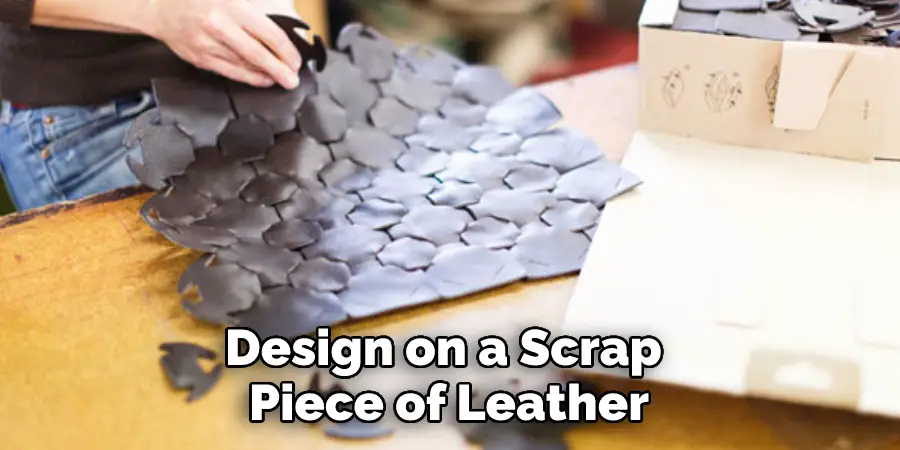
By following these simple tips, you can achieve beautiful and professional-looking results when laser engraving leather. Keep reading for more information about how to laser engrave leather.
Few Things to Consider When Laser Engraving Leather
Engraving leather has been a popular hobby for many years, but it is also gaining popularity as a professional service in customizing leather items either with text or designs.
Laser engraving has become an incredibly efficient and precise way to do this. Here are few things to consider when laser engraving leather:
- Type of Leather: The type of leather you will use is an important consideration when it comes to laser engraving leather. Different types of leather will require different settings when using a laser machine. It is best to do some research about the type of leather you plan on working with before starting the project.
- Design: If you plan on engraving a design instead of text, it’s best to start with sketching a simple outline or line drawing of your desired design on paper first. After that, you can convert the file into vector lines which can be uploaded into software used by most laser machines. This ensures that the details in your design don’t get lost during the engraving process.
- Laser Power: When selecting the right power for your project, it’s important to understand what factors will affect your results, such as the thickness and texture of the material, colors, finishes being used, etc. It is best to start with lower power and gradually increase until you reach your project’s optimal results.
Engraving leather can be a fun and exciting activity for hobbyists and professionals. A little bit of preparation goes a long way in ensuring successful results when laser engraving leather!
5 Tips for Cleaning and Maintaining Your Laser Engraved Leather
Leather is a classic material that never goes out of style. However, if you have a laser-engraved leather piece, it’s important to know how to care for it properly. Here are five tips for keeping your laser engraved leather looking its best:
1. Use a soft, dry cloth to dust the surface of the leather. Avoid using water or other liquids, as this can damage the engraving.
2. If there are any spills on the leather, blot them up immediately with a clean, dry cloth. Do not rub the spill, as this will only spread the stain and make it more difficult to remove.
3. To clean stubborn dirt or stains, make a paste with equal water and baking soda. Then, gently rub the paste into the stain using a soft, dry cloth. Once the stain has been removed, wipe away any leftover paste with a damp cloth.
4. Every few months, treat your laser engraved leather with a quality leather conditioner. This will help keep the leather supple and prevent it from drying out and cracking over time.
5. When not in use, store your laser engraved leather in a cool, dry place away from direct sunlight. This will help to prevent the leather from fading or discoloring.
By following these simple tips, you can keep your laser-engraved leather looking new for years to come.
Ways to Troubleshoot Common Laser Engraving Problems
If you’re having trouble getting your laser engraver to work properly, you can try a few things. First, check the power supply and make sure it is turned on and set to the correct voltage. Next, check the connections between the laser engraver and the power supply. Make sure that all cables are securely connected and that there are no loose wires.

If everything looks okay there, check the laser itself. Make sure that it is properly aligned and that nothing is blocking the beam. Finally, if all else fails, consult the user manual or contact the manufacturer for further assistance. With a little troubleshooting, you should be able to get your laser engraver up and running in no time.
Common Mistakes Made When Laser Engraving Leather
Leather is a beautiful, natural material that can add a touch of elegance to any laser engraving project. However, keeping a few things in mind when working with leather is important, as it can be difficult to engrave evenly and consistently. Here are some common mistakes made when laser engraving leather and how to avoid them:
1. Not using the right settings. Leather is a thicker material than paper, so you’ll need to adjust your laser engraver’s settings accordingly. If you’re not sure what settings to use, it’s always better to err on the side of caution and start with lower settings before gradually increasing the power.
2. Not prepping the surface properly. Before you start engraving, it’s important to clean the leather’s surface and ensure it’s free of any dirt or debris. Otherwise, your engraving will be uneven and may even cause damage to the leather.
3. Engraving too deeply. When engraving leather, it’s important to go slow and steady your hand to avoid going too deep. If you engrave too deeply, you risk cutting through the leather completely, which ruins the piece.
4. Not using the right type of leather. Some types of leather are easier to engrave than others. If you’re not sure what type of leather you have, it’s best to consult with a professional before starting your project.
5. Not testing the design first. Before you start engraving your final piece, it’s always a good idea to test the design on a scrap piece of leather first. This way, you can make sure the engraving is how you want it and make any necessary adjustments before starting the final piece.
With these tips in mind, you’ll be well on your way to creating beautiful, laser-engraved leather projects. Just remember to take your time, use the right settings, and prep the surface properly before you start. And if you’re ever unsure about anything, be sure to consult with a professional before moving forward.
Frequently Asked Questions
Should You Wet Leather Before Laser Engraving?
Every situation is different, and the appropriate protocol for wetting or not wetting leather before laser engraving will vary depending on the specific situation. That said, there are a few general tips that can be helpful in most cases:

- Test the water temperature before starting – Many engravers recommend testing the water temperature before starting any engraving project to make sure it is safe for your equipment and skin.
- Wet the leather until it is moist but not dripping – Make sure to wet the leather until it is completely saturated, but do not let it drip. This will help to prevent any accidents and keep the surface clean and free from debris.
- Keep your hands clean – Always keep your hands clean and free from oils or other contaminants. This will help to ensure that the laser does not build up on your skin and cause any damage.
- Be patient – Laser engraving is a slow process, so patience is key! Do not get discouraged if results do not seem immediate – eventually, they will start to show up!
What Leather is Best for Laser Engraving?
There are so many different types of leather and each has its own unique features and benefits. That said, some of the more popular leathers for laser engraving include cowhide, buffalo hide, pigskin, lizard skin (pictured), chamois (a type of goat), and snake skins.
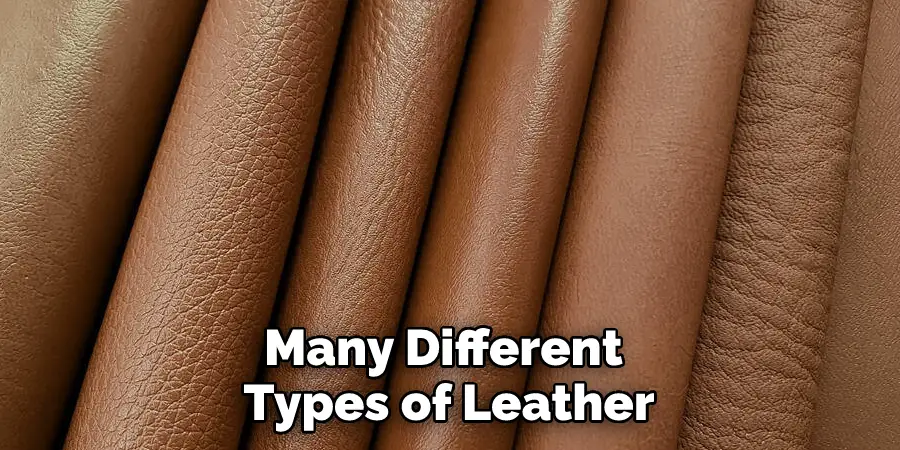
Each material has its own properties that make it ideal for specific uses. For example, cowskin is strong yet supple enough to handle delicate artwork without tearing or cracking; reptile skins are water repellent which makes them perfect for projects that need protection from liquids such as ink, and pig skin tends to be less expensive than other options but still holds up well to repeated drawing and laser cutting.
Ultimately it becomes important to test various materials in advance by trying out a few samples on your desired project before committing to a final product. This way you can ensure that your artwork will look great with any type of leather!
Is It Better to Engrave or Emboss Leather?
Engraving or embossing leather can add a high-quality finish to your garments, but it is also possible to damage the surface if done incorrectly. It is important to use a fine-pointed instrument and apply even pressure while working in order to avoid gouges or tears. Additionally, heat should never be applied directly against the leather as this can cause permanent damage.
Masterpiece Leathercrafts offers both engraving and embossing services that are perfect for adding that extra bit of personality and luxury to your clothing items. We use the latest equipment and techniques so you know your garment will look amazing from start to finish!
Does Laser Engraving Last Forever?
Unfortunately, no… laser engraving will eventually fade and lose its clarity over time. This is due to the fact that lasers emit harmful light waves that damage the surface of the object being engraved. As a result, faded or unclear design would be visible even if it was covered up with an enclosure or coating.
To prevent this from happening, make sure to clean your laser regularly and protect your work area from dirt and dust accumulation. Additionally, use a clear material like acrylic when mounting images onto Plexiglas (this will also help reduce glare). And lastly, choose a high-quality laser for the best results possible!
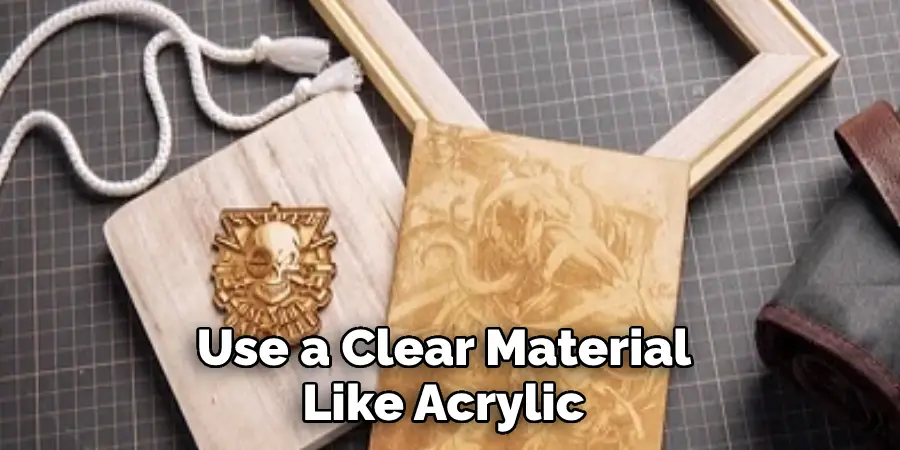
Conclusion
If you are looking for a unique, one-of-a-kind gift that will impress, consider laser engraving leather. Not only is it beautiful and stylish, but it is also incredibly durable and long-lasting.
With just a few simple steps, you can create a stunning piece of personalized leather art that will last for years. Thanks for reading our post about how to laser engrave leather. So what are you waiting for? Start laser engraving today!

